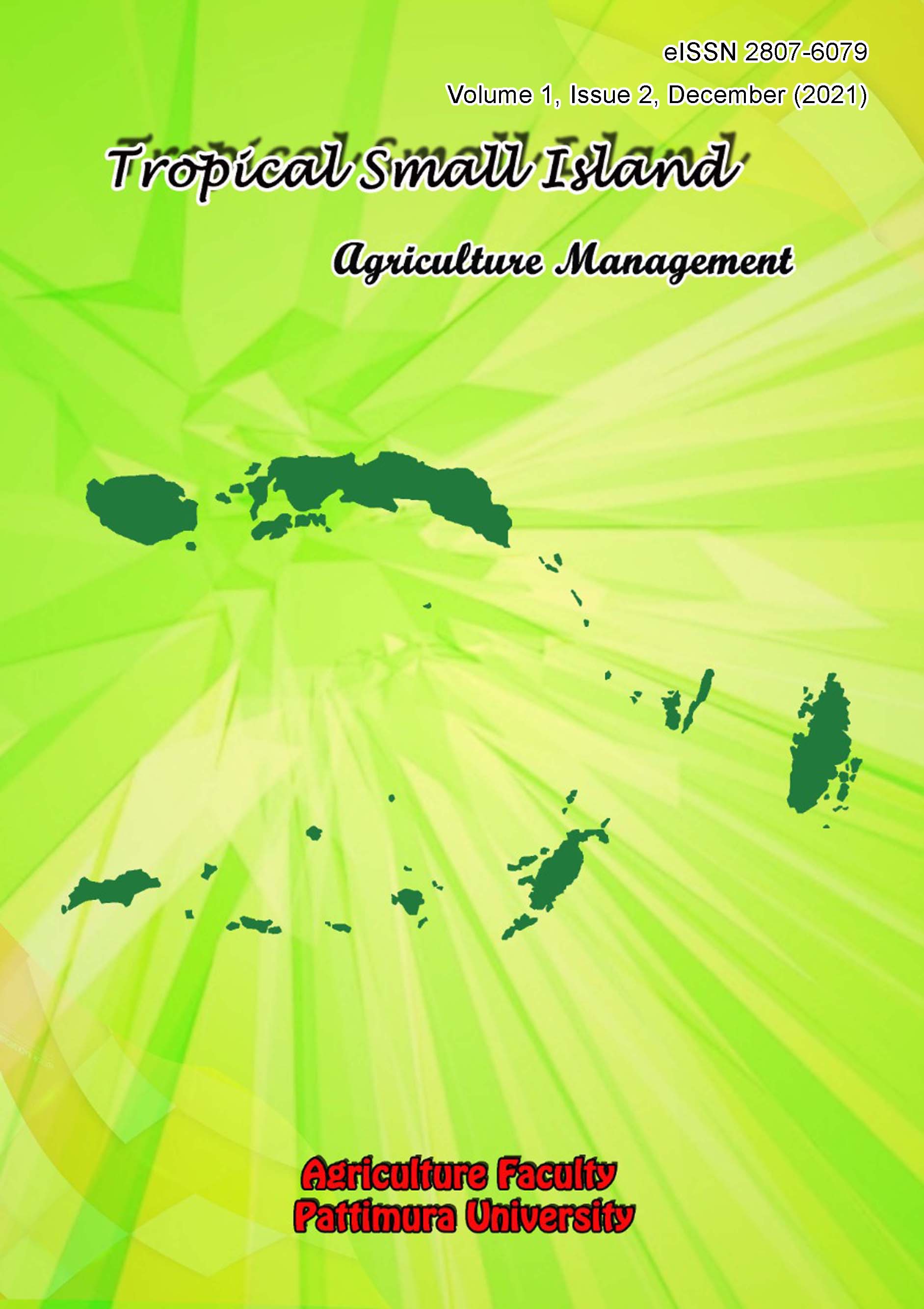Agro-Economic of Dusun Systems in Small Islands: A Case of Ambon City, Maluku Indonesia
Abstract
Whereas many studies highlight positive environmental and socio-economic effects of agroforestry systems, the agro-economic effect of Dusun practices as indigenous agroforestry systems has rarely been studied in detail, particularly in small island-Maluku Indonesia. This article examines the agro-economic of tropical perennial and annual fruit crops in the Dusun systems in Ambon city islands. A survey was conducted in three different Dusuns to obtain data through in-depth interviews of 88 heads of households. Our findings indicate that most Dusun farmers are uneducated and old age, half of them have small size of land, and 95% of land status belongs to kinship-clan ownership. Then, half of the farmers have an elementary school education, and 71% have a primary job as farmers, while 29% have a secondary job on the farm and non-farm activities. Amongst 26 crops that are found in three Dusun areas, nine crop types can be found in the whole Dusun, while the rest are located in one or two Dusun only. These crops are grown together and form multiple cropping structures from high stratum like durian and coconut to medium strata such as clove and nutmeg and low strata such as vegetables and tubers. The structures of the crops have an important role in maintaining biodiversity, minimizing soil erosion, water reservoir, and supporting socio-economic of the households. Annual income from rural household was estimated at around US$6487 or US $3.6/capita/day. Income average value was almost two folds of the World Bank poverty line standard. Nearly 80% of the total income are contributed by four main crops, i.e. clove (Eugenia aromaticum), durian (Durio zibethinus Mur), nutmeg (Myristica fragnans), and duku (Lansium domesticum), of which 11% is contributed predominantly by snake fruit (Salacca zallaca var amboniensis Becc), mangosteen (Garcinia mangostana L) and langsat (Lansium domesticum).
Downloads
References
Adegbehin, J.O. & Igboanugo, A.B.I. (1990). Agroforestry practices in Nigeria. Agroforestry Systems, 10, 1-22.
Arifin, H.S., Sardjono, M.A., Sundawati, L., Djogo, T., Wattimena, G.A., & Widianto. (2003). Bahan Latihan Agroforestry di Indonesia. World Agroforestry Centre (ICRAF), pp.39. Bogor [Material training for Agroforestry in Indonesia].
Craswell, E.T., Sajjapongse, A., Howlett, D.J.B., & Dowling, A.J. (1998). Agroforestry Systems 38, 121-137.
Dove, M.R. (1983). Theories of swidden agriculture, and the political economy of ignorance. Agroforestry Systems, 1, 85-99.
Ducos, L. (2014). Importance of the traditional land-use and land-tenure systems of Waraka, Seram Island, Maluku. Working Paper 144. Bogor, Indonesia: CIFOR. pp. 73. Hong Kong: Periplus Editions.
Girsang, W. (2011). Kemiskinan Multidimensional di Pulau-Pulau Kecil. Badan Penerbit Fakultas Pertanian Universitas Pattimura Ambon. Ambon. pp. 347.
Islam, K.K., Jose, S., Tani, M., Hyakumura, K., Krott, M., & Sato, N. (2015). Does actor power impede outcomes in participatory agroforestry approach? Evidence from Sal forests area, Bangladesh, Agroforest Syst, Published on line, 23 June 2015.
Kaya, M., Kammesheidt, L., & Weidelt, J. (2001). The forest garden system of Saparua island, Central Maluku, Indonesia, and its role in maintaining tree species diversity, Agroforestry Systems, 54, 225–234.
Kulshreshtha, S., & Kort, J. (2009). External economic benefits and social goods from prairie shelterbelts. Agroforestry System, 75, 39–47.
Kumar, B.M. & Nair, P.K.R. (2004). The enigma of tropical home gardens. Agroforestry Systems
Lisa, Fouladbash, L., & Currie, W.S. (2015). Agroforestry in Liberia: Household practices, perceptions and livelihood benefits. Agroforestry System, 89, 247–266.
Lu, S., Wang, F., Meng, P. & Zhang, J. (2015). Simultaneously protecting the environment and its residents: The need to incorporate agroforestry principles into the ecological projects of China. Ecological Indicators, 57, 61–63.
Matinahoru, J. M. (2014). A Review on Dusun as an Indigenous Agroforestry System Practice in Small Island, in Yamamoto, S. and Rahardjo, S (Eds), A New Horizon of Island Studies in the Asia-Pacific Region, Occasional Paper No.54, December 2014, Kagoshima University Research Center for the Pacific Islands. Japan.
Mithöfer, D., & Waibel, H. (2003). Income and labour productivity of collection and use of indigenous fruit tree products in Zimbabwe. Agroforestry Systems 59, 295–305.
Mogea , J., Seibert, B., & Smits, W. (1991). Multipurpose palms: the sugar palm (Arenga pinnata (Wurmb) Merr.), Agroforestry Systems, 13, 111-129.
Molua, E.L. (2005). The economics of tropical agroforestry systems: the case of agroforestry farms in Cameroon. Forest Policy and Economics, 7, 199–211.
Monk, K., De Fretes, Y. & Reksodiharjo-Lilley, G. (1997). The Ecology of Nusa Tenggara and Maluku.
Montambault, J.R., Janaki R.R. & Alavalapati, (2005). Socioeconomic research in agroforestry: A decade in review. Agroforestry System, 65, 151–161.
Nair, P.K.R. (1998). Directions in tropical agroforestry research: Past, present, and future, Agroforestry Systems, 38, 223–245.
Neupane, R.P. & Thapa, G.B. (2001). Impact of agroforestry intervention on soil fertility and farm income under the subsistence farming system of the middle hills, Nepal. Agriculture, Ecosystems and Environment, 84, 157–167.
Neupane, R.P., Sharma, K.R., & Thapa, G.B. (2002). Adoption of agroforestry in the hills of Nepal: A logistic regression analysis. Agricultural Systems, 72, 177–196.
Nevenimo, T., Moxon, J., Wemin, J., Johnston, M., Bunt, C., & Leakey, R.R.B. (2007). Domestication potential and marketing of Canarium indicum nuts in the Pacific: A literature review. Agroforestry System, 69, 117–134.
Okubo, S., Parikesit, Harashina, K., Muhamad, D., Abdoellah, O.S., & Takeuchi, K. (2010). Traditional perennial crop-based agroforestry in West Java: The trade-off between on-farm biodiversity and income. Agroforestry System, 80, 17–31.
Rasul, G., & Thapa, G.B. (2003). Sustainability analysis of ecological and conventional agricultural systems in Bangladesh. World Development, 31(10), 1721–1741. www.elsevier.com/locate/worlddev
Rasul, G., & Thapa, G.B. (2004). Sustainability of ecological and conventional agricultural systems in Bangladesh: an assessment based on environmental, economic and social perspectives. Agricultural Systems, 79, 327–351. ww.elsevier.com/locate/agsy
Rogers, E. (2003). Diffusion of Innovations, 5th Edition. Simon and Schuster.
Salampessy, M., Nugroho, B., & Purnomo, H. (2010). Partisipasi kelompok masyarakat dalam pengelolaan kawasan hutan lindung, kasus di Hutan Lindung Gunung Nona Kota Ambon Propinsi Maluku. Jurnal Perennial, 6(2), 99-107.
Schwab, N., Schickhoff, U. & Fischer, E. (2015). Transition to agroforestry significantly improves soil quality: A case study in the central mid-hills of Nepal. Agriculture, Ecosystems and Environment, 205, 57–69.
Silaya, Th., & Hatulesila, J.W. (2008). Penguatan Hak Masyarakat Dalam Pengelolaan Sumberdaya Hutan Di Desa Uwen Dan Sekitarnya Kecamatan Taniwel. Faculty of Agriculture, University of Pattimura, pp.23. http://www.irwantoshut.com
Snelder, D.J., Klein, M., & Schuren, E.S.H.G. (2007). Farmers preferences, uncertainties and opportunities in fruit-tree cultivation in Northeast Luzon. Agroforestry System, 71, 1–17.
Tremblay, S., Lucotte, M., Reve´ret, J.P, Davidson, R., Fre´de´ric Mertens, Jose, C., Passos, S., & Romana, C.A. (2015). Agroforestry systems as a profitable alternative to slash and burn practices in small-scale agriculture of the Brazilian Amazon. Agroforestry System, 89, 193–204.
Copyright (c) 2024 The Author(s)

This work is licensed under a Creative Commons Attribution-ShareAlike 4.0 International License.
Authors who publish with this journal agree to the following terms:
- Authors retain copyright and grant the journal right of first publication with the work simultaneously licensed under a Creative Commons Attribution License that allows others to share the work with an acknowledgment of the work's authorship and initial publication in this journal.
- Authors are able to enter into separate, additional contractual arrangements for the non-exclusive distribution of the journal's published version of the work (e.g., post it to an institutional repository or publish it in a book), with an acknowledgment of its initial publication in this journal.
- Authors are permitted and encouraged to post their work online (e.g., in institutional repositories or on their website) prior to and during the submission process, as it can lead to productive exchanges, as well as earlier and greater citation of published work (See The Effect of Open Access).









